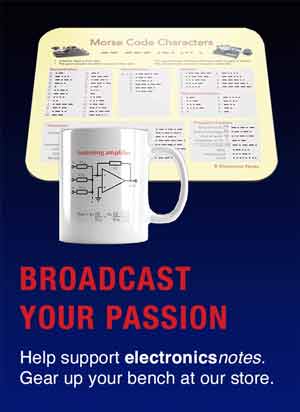Home » Component data » Diode (Schottky) data » this page
NRVB120 Schottky Diode Data
Key data for the NRVB120 Schottky diode including key electrical parameters, performance, features, outline, package type and many other key datasheet details.
The NRVB120 uses the Schottky Barrier principle with a large area metal−to−silicon power diode. It is ideally suited for low voltage, high frequency rectification or as free wheeling and polarity protection diodes in surface mount applications where compact size and weight are critical to the system.
Although virtually identical to the MBR120, the NRVB120. However the "NRVB" prefix specifically indicates that the device is AEC-Q101 qualified.
AEC-Q101 is a standard set of stress tests and qualification procedures established by the Automotive Electronics Council (AEC) for discrete semiconductor components.
Devices with this qualification are designed to withstand the much harsher operating environments found in automotive applications.
Key details and datasheet performance parameters for the NRVB120 diode.
| NRVB120 diode datasheet parameters & data |
|
|---|---|
| Parameters | Details |
| Diode type | 1A 20V power rectifier |
| Package type | SOD123 |
| Repetitive peak reverse voltage, VRRM | 20V |
| Working peak reverse voltage, VRWM | 20V |
| DC blocking voltage, VR | 20V |
| Average rectified current, IF(AV) | 1.0A |
| Non-repetitive forward surge current, IFSM | 45A |
| Power dissipation, PTOT | |
| Junction temperature (°C) | 125°C |
| Forward voltage VF | For IF = 0.1A, VF = 0.275V typ at 25°C and 0.205V at 85°C For IF = 0.5A, VF = 0.315V typ at 25°C and 0.270V at 85°C For IF = 1.0A, VF = 0.340V typ at 25°C and 0.300V at 85°C |
| Reverse leakage IR | 0.60mA at 25°C and 15mA at 85°C at rated DC voltage |
Outline & pinout:
Explanation of major diode parameters
| Parameter | Explanation |
|---|---|
| Repetitive peak reverse voltage, VRRM | This is the maximum value of the short period peak reverse voltage that can be sustained. |
| Working peak reverse voltage, VRWM | This is the maximum value of the continuous reverse voltage that can be applied to the diode. |
| DC blocking voltage, VR | This is the maximum reverse DC voltage that should be applied across the diode. |
| RMS reverse voltage, VR(RMS) | As many AC waveforms are quoted in RMS, this is the maximum reverse voltage that can be sustained where the voltage is expressed in terms of its RMS value. |
| Forward continuous current, IF | This is the maximum forward current that can be sustained by the diode. |
| Average rectified current, IF | This is the maximum average current value that can be handled by the diode. The parameter often states the load as this will affect the operation of the diode. |
| Non-repetitive forward surge current, IFSM | This is the maximum surge current that can be handled - it should only be present for a short time. |
| Parameter | Explanation |
|---|---|
| Power dissipation, PTOT | The maximum power dissipation that can be sustained within the device. |
| Junction temperature (°C) | This is the maximum temperature of the PN junction that can be sustained. Remember that the junction temperature can be much higher than the ambient temperature of the equipment. |
| Forward voltage VF | This parameter gives the forward voltage drop for a particular current passed through the diode. |
| Breakdown voltage VBR | This is the minimum voltage at which the diode may breakdown. If the current is not limited it will lead to the destruction of the device. |
| Leakage current IR | This is the current that flows under stated conditions when the diode is reverse biassed. |
| Diode capacitance CD | The diode capacitance, CD may also be referred to as the junction capacitance, CJ. All diodes have a certain capacitance across the PN junction. The value will be stated for a given reverse voltage. |
| Reverse recovery time | If a diode is initially driven in forward bias, and the polarity suddenly switches to reverse bias, the diode will still remain conducting for some time. The reverse recovery time is the time required for conduction to settle into the reverse bias state. |
These are the main Schottky diode parameters that have been included in our list. There are others, but these help quantify the main elements of the performance of the diode.
Please note, that the data given is the best estimate we can give within a tabulated summary of this nature. Parameters also vary between manufacturers. Electronics Notes cannot accept any responsibility for errors, inaccuracies, etc, although we do endevaour to ensure the data is as accurate as possible.
Notes and supplementary information
• Availability & sources
The NRVB120 is available from a number of stockists and electronic component distributors many of which are given in the table below.
NRVB120 Component Distributor, Stock and Pricing
• Further details
Because of its small size, the NRVB120 is ideal for use in many applications but has been qualified to AEC-Q101 for automotive applications.
However, typical applications are AC−DC and DC−DC converters, small current reverse battery protection, and “Oring” of multiple supply voltages and any other application where performance and size are critical.
 Written by Ian Poole .
Written by Ian Poole .
Experienced electronics engineer and author.
Return to Component Data menu . . .




